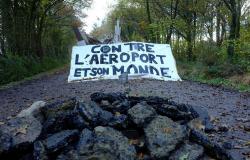How to Win: Lessons from the Zad

Successful social movements combine resistance to injustice with the affirmation of alternatives.
After 50 years of struggle, 10 years of physical occupation and over 11,000 canisters of tear gas, that rarest of things happened to one of France’s most infamous social movements: they won. In January 2018, plans for the Gran Ouest airport, in the making for half a century, were cancelled. The 4,000-acre territory known as the Zone to Defend or “Zad” was saved. This means that local ecosystems, the world’s atmosphere and all of our lungs have been spared the impact of hundreds of extra flights a day.
In the gloomy world of environmental activism, victories like these are hard to come by, and when they do happen they are rarely celebrated. What are a few hundred fewer planes a day when compared to the thousands that still fly? But this is a crippling attitude. If we don’t pay attention to our victories we won’t learn from their success. Perhaps even worse, we’ll deprive ourselves of stories full of hope.
Fledgling direct-action movements like Extinction Rebellion and the Youth Strike are mobilising across the globe. They need help to avoid repeating the mistakes of the past and inspiration to sustain themselves. Though the Zad’s struggle is particular to its time and place, its lessons apply much more broadly. So, how did they win?
I went to France to listen to as many versions of this long, dramatic story as I could. Details and emphases change, but everyone I spoke to described how important it was to build a community around the resistance. When a radical farmer asked the first squatters for help in 2008 they immediately began putting down roots. In 2009, these occupiers asked hundreds of activists attending a Climate Camp in the zone to stay and help defend the territory. In the decade of tense and violent stand-offs with the state that followed, they built a deep, diverse and open community of resistors.
At a glance, the infrastructure of the Zad resembled any other community, with a radio station, a local news bulletin, a bakery, a shared garden and even a brewery. But this community was different, because its members cared deeply for their natural environment, managed resources collectively and dismantled hierarchies wherever they could. It was a laboratory for society. At its peak, over 70 different collectives were experimenting with lives built on cooperation, autonomy and affection, all while resisting the new airport, a major piece of capitalist infrastructure. John, a long-term inhabitant of the zone, described this as the Zad’s unique DNA: it combined the ‘Yes’, an affirmation of an alternative, with the ‘No’, a resistance to injustice.
We need both ‘alternative cultures’ and ‘oppositional cultures’ working side by side. All successful social movements have had both, including the Suffragettes and the American Civil Rights movement, as writer and activist Lierre Keith describes in Deep Green Resistance, a 2011 strategy manual for radical environmentalists. Opposition without an alternative will burn out. An alternative without opposition will stagnate.
Keith fiercely criticises the latter. She rails against the drop-out communities in 1960s America as irresponsible and immature. Instead, she says, we need to embed resistance into our everyday lives, normalising and supporting it to infuse a different way of doing things, what she calls a ‘culture of resistance.’ There are many ways in which this combination can be worked out. The Zad offers a great example. This is perhaps the most important lesson to be learned: successful movements must combine their opposition with alternatives and vice versa.
In addition, the Zad is not a clandestine radical cell. Despite all the energy it has taken, the Zad’s inhabitants have worked incredibly hard to welcome visitors and newcomers; I can testify to this from my visit and the convivial culture I found there. Farmers and naturalists, Marxists and anarchists, punks and middle-class intellectuals all came together to defend the territory.
Outside of a local police station at a solidarity protest for five people charged whilst defending the zone, John points at the crowd who have gathered on a windy, wet Monday morning and says “it’s this that won the struggle. It’s the peasants, the old aged pensioners, the villagers, the squatters - it was everyone who managed to make these unexpected alliances.” Every day this broad coalition navigated their differences, worked out compromises and built trust.
As well as adding legitimacy and numbers, the Zad’s diversity created concrete tactical advantages. When a citizen shared a contractor’s drilling plans, for example, legal experts explained that drilling was illegal if it took place near an animal waste area, so the farmers lent tractors and manure and the drill-sites were sabotaged. The contractor refused to work on the zone after that.
The breadth of participants also gave the movement a wide reach across France. Despite caricatures from the state and many media outlets of the ‘zadists’ as balaclava-wearing eco-terrorists, the Zad had enormous popular support. The image of the movement became so powerful that other Zads, in Testet, Chambéry and most recently in Northern Paris, have appeared to wage their own territorial defences.
In particular, a road going through the heart of the zone, the Route de Chicane, became a potent symbol of the movement. It was described to me as an “absolutely extraordinary, anarcho-primitivist, Mad Max kind of road.” Blockaded by huts, towers, gardens and barricades, it represented the kind of unusual encounters the Zad enabled. People gathered to live, eat and play. It was spontaneous, communal and sometimes chaotic. This is the second lesson to learn from the Zad: successful movements must invite difference and create spaces for differences to mingle.
Having land on which to build community helps here, but the Zad was only able to incorporate so much difference because it had a clearly defined enemy. The airport rallied people across social groups in a way that eco-villages, permaculture retreats and off-the-grid communes rarely can.
As Kristin Ross put it in the preface of the The Zad and Notav, the Zad presented an “existential and political choice – one is either for the airport or against it.” The Zad’s slogan was famously “Against the airport and its world.” This nestled a larger politics inside opposition to a clearly defined political opponent – far clearer than something like ‘capitalism’ or the ‘state.’ This is the third lesson: successful movements must have a distinct opponent.
The importance of this point is borne out by the events that followed the airport’s cancellation in 2018. Since the common enemy-dragon-airport was slain, some cracks in the alliance have begun to show. Ironically, tensions converged around the Route de Chicane. In the same speech that cancelled the airport, the French Prime Minister announced that the road would be cleared. This split the farmers, citizens and squatters. By all accounts the year since has been the most taxing of the whole occupation, full of arguing, negotiating and compromising.
This does not diminish the importance of having a diversity of people and worldviews in a movement, but it does raise questions. The Zad now faces a political and existential crisis. Activists, both in the movement and elsewhere, must wonder, could this have been anticipated?
Another long-term inhabitant, Isabelle, suggests an answer when she explains that “we don’t know how to deal with victory.” She cites David Graeber, a theorist and activist, who wrote in 2007 that dealing with victory is “the biggest problem facing direct action movements.”
Hindsight is a comfortable position from which to speak, but if the inhabitants of the Zad had expected their victory, perhaps bridges could have been built over the schisms that were bound to open up after it had been achieved. In any case, their experience tells us that we cannot have faith that a revolutionary struggle will magically align all of its conflicting worldviews. We need to anticipate the hangover that follows a successful revolution and plan for it. This is the final lesson from the Zad’s story so far: successful movements need to be prepared to win.
Starting from this position - that winning is possible - fosters optimism and hope, which are vital resources in our age of cynicism. As Isabelle went on to explain to me, some on the Zad are exhausted because they haven’t acknowledged their victory. She explains how they “keep shifting the goalposts.” First they were against the airport, but after winning they were against its wider world. “No, we haven’t brought down capitalism,” she continued, “we haven’t stopped climate change, and there are still migrants that get tortured and fascism is still rising. Yes, all of that. There’s no doubt about that. We haven’t had the victory, because I don’t think it will ever happen. But it is a victory.”
The Zad, like all movements, is a victory as well as a victory in progress. To survive, it must learn the lessons of its own struggle. More importantly, other progressive social movements must look to victories like these and learn their lessons too. We cannot face our challenges from a position of pessimism or defeatism. If we want to live in a better world we must create it now, wherever we can, and not wait to confront whatever power would stop us.
Greg Frey is an activist in the UK with Extinction Rebellion and a writer interested in art, politics and humans who do more than expected.
This first appeared on:

This article is re-published under a Creative Commons Attribution-NonCommercial 4.0 International licence. If you have any queries about republishing please contact us. Please check individual images for licensing details.
Image: A barricade at the Notre-Dame-des-Landes ZAD, November 2012. Bstroot56 via Wikimedia Commons. CC BY-SA 4.0.

